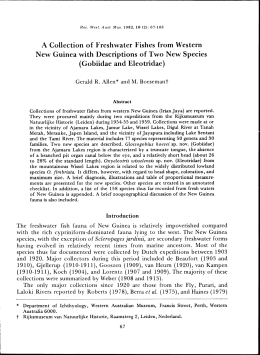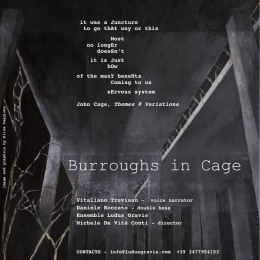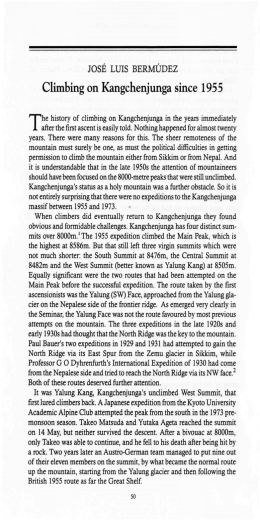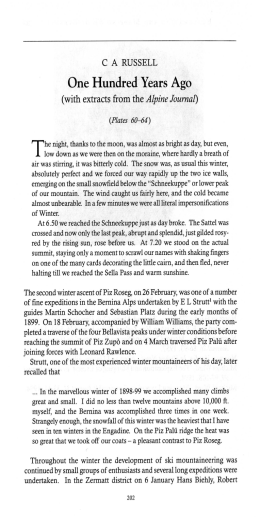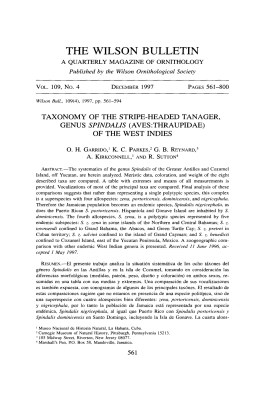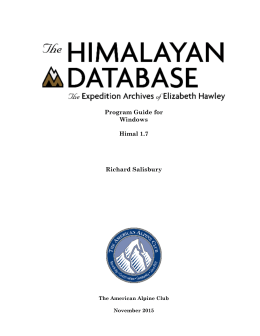186 Reviews [Auk, Vol. 94 Mr. Hay's book is, by contrast, a personaland poetic view of the yearly cycle in the life of terns. He traveled extensively,visiting tern coloniesin Europeand America, and the book includesboth his esthetic appreciation of their beauty, his admiration for their struggle to survive the encroachment of man on their breeding areas, and factual knowledge acquired through his researchesand visits to colonies.It is wellwritten and often evocative, very much in the tradition of his earlier books. MARY LECRO¾. ALSO RECEIVED The birds of John Burroughs, keeping a sharp iookout.--Jack Kligerman (Ed.). 1976. New York, Hawthorne Books, Inc. Pp. 240, illus. by Louis AgassizFuertes and a photographof John Burroughs.$3.95. Every oncein a while a bookof the past is reprinted not just becauseit is at last in public domain and will probably sell but becauseit is one of the best of its kind and should not remain forever forgotten. Such a book is this collection of Burroughs' essays.I wish I could have the pleasure of reading it for the first time all ovcr again and would rccommend it as lcisure-time reading to anyone with an appreciation of birds and nature.--ELIZABETH S. AUSTIN. Birds of prey of Wiseonsin.--Frances Hamerstrom. 1972. Madison, Wisconsin,Department of Natural Resources. Pp. 65, illus. by Elva Paulson. No price given. This excellent paperback packs a great deal of pertinent and accurate information into limited space. Anyone writing regimml reports for the general public would profit by using this booklet as a model. The Department of Natural Resourcesof the State of Wisconsin is to be commended for making such information available to the state's citizens.--ELIZABETH S. AUSTIN. OBITUARY R/CHARDARCHBOLD,1907-1976: explorer, world traveler, aviator, mountain climber, naturalist, and patron of natural history studies. He was educated chiefly at private schools.Richard came early under the influence of Herbert Stoddard who lived near his family's plantation near Thomasville, Georgia. While at schoolnear Tuscon, Arizona he became fascinated with primitive travel in the desert wilderness. In 1928, through the good officesof Dr. L. C. Sanford, a trustee of the American Museum of Natural History in New York, Richard was invited to participatein a proposedFrench-British-Americanzoological expeditionto Madagascar (1929-1931) to which his family contributed generously.This was under the general leadership of the noted French ornithologist, M. J. Delacour. Richard was responsiblefor the mammal collecting and study. Once the expeditionwas well startedDelacourand his assistantwent on to Indochinaas planned. Soon after this the death of Richard's father called Richard home and both bird and mammal collecting was continued by txvo bird men until 1931. Richard then became interested in the Indo-Australian region and planned a series of expeditions to New' Guinea. The first, with specialistscollecting mammals, birds, and plants, was to southeastNew Guinea (1933 34) working from sea level to Alpine tundra using conventional equipment, pack animals, and carriers. After this experience,Archboldbecameinterestedin using airplanesfor expeditiontransportinto unexploredareasand portable radiosfor communicationbetween camps. The working out of plans and special equipment occupiedmuch of his attention. The secondNew Guinea expedition, 1936-37 was planned for the extensive lowlands of south New Guinea (the Fly River area) and the mountains of the central divide to the north utilizing both plane and radio. A mammalogist was added to the biologicalfield staff which also included an ornithologist and a botanist. Ttie loss of the plane at anchor in a sudden tropical storm curtailed field work to the extensiveFly River lowlands and travel to boat and raft. The third expedition(1938-39) to New Guinea was to explorethe countryfrom the north coastlowlands to the to[> of the Snow Mountains, with a series of camps in between. This was in Netherlands New' Guinea and the expedition became international with the Netherland Indies providing a military escort under a captain, a forester, and an entomologist,and also recruited a crew of Dyacks from Borneo for expedition porters. January 1977] Obituary 187 The expedition's flying boat was flown from the U.S. by Archbold and crew to the base camp at Hollandia on the north New Guinea Coast. From here it was used to transport personnel and supplies to rivers and lakes inland. The whole operation went off remarkably smoothly under the overall guidance and support of Archbold. But collectingof specimensled to a desireto find out moreabout the organismscollected,their lives and ecology.Archbold began thinking about a biological station to study the biota in situ. Construction of a headquarters building at Hollandia on the north coast of New Guinea near the base camp of the third expedition was begun. However unsettled world conditionsprecludedan immediate start of this project. In an attempt to hold his staff togetherArchbold establisheda temporary field stationin the Arizona desert near Tucson where a successful season's work was carried out on birds and mammals in 1940. Then through an old schoolfriend, Donald Roebling, Richard in 1941 was offered the Roebling Red Hill property near Lake Placid, Florida for scientificpurposes.This became the permanent Archbold Biological Station, a more than 4-sq-mile tract of pine-oak scrub, a relic of primitive vegetationof the sand ridge country of south Florida, plus a complex of concretebuildings for headquarters and laboratories. Archbold himself took no further active part in the collectingexpeditionsfor mammals and plants after his establishmentof the biological station but remained at Red Hill for the rest of his life. He had a small permanent staff and a continual shifting stream of investigatorsin many aspectsof biology with special needsand equipment. The challengesand the problemsthat Richard could help solve by'devising equipment and offering encouragementkept him busy here for many years until he passedaway'peacefullyon 1 August 1976. The American share of the Archbold bird collections are in the American Museum of Natural History in New York. Notable are thosefrom Madagascarand New Guinea. The bird collectorsfor one or more expeditionswere J. Delacour, J. C. Greenway, Jr., Willoughby Lowe, Philip Dumont, and A. L. Rand. Examples of the bird work done at the Archbold Biological Station include "Enemy recognitionof the Curve-billed Thrasher," a list of the birds of the biologicalstation, Florida; and paperson the socialand family interrelationshipsof the Scrub Jay'by Glen Woolfenden. In writing the above, I have givenonly someof the bare bonesof Richard Archbold'scareeras relatedto or.nithology and only someof his other interests.But I must add that for many years he was a companion and a closefriend, in tropical forest and in desert, in museum laboratory' and in biological field station. May he rest in peace.--A. L. RAND NOTES AND NEWS The Frank M. Chapman Memorial Fund of the American Museum of Natural History is administered by a committee that meets twice annually to review applications for grants and fellowships. While there is no restriction on who may apply, the Committee particularly welcomes and favors applications from graduate students;projects in game managementand the medical sciencesare seldom funded. Applicationsshouldbe submittednot later than 15 February and 15 September. Application forms may be obtained from the FRANK M. CHAPMANMEMORIAL FUND COMMITTEE, The American Museum of Natural History, Central Park West at 79th St., New York, N.Y. 10024. Julian Ford has been appointed a Chapman Fellow for 1976. He is studying the geographicaldistribution and systematicsof Australian birds. Chapman grants during 1976, totalling $53,100 with a median of S500, were awarded to: Walter L. Anderson,spatial ecologyof birds in northern Michigan bogs;Allison V. Andors, systematics,evolution, and biogeographyof the Diatrymidae and Gastornithidae;Marcus W. Armstrong,Jr., seasonalvariation in mockingbirdrepertoiresize;Patricia C. Afrowood, antiphonalsingingin Canary-wingedParakeets; Robert A. Askins, comparative ecologyof temperate and tropical woodpeckers;Jonathan L. Atwood, socialinteractionsin Santa Cruz I. ScrubJays;Martha H. Balph, winter socialorganizationof Evening Grosbeaks;G. ThomasBancroft, comparisonof molt in Blue and ScrubJays;Jon C. Barlow, evolutionary trends and systematicsof Black-whiskered and Yucatan vireos; Steven R. Beissinger,bird species diversit5,in natural and man-organizedtropicalcommunities;Peter Boag, significanceand maintenanceof morphologicalvariation in Geospizafortis; Jos6 F. Bonaparte, Upper Cretaceouscontinental birds from South America; Michael deL. Brooke, breeding status and sex ratio of Manx Shearwaters in Bay of Biscay; Sadie C. Brown, systematicsof Glaucidium; Dirk Burcham, determination of Dunlin breeding groundsby trace elements;Everette L. Busbee,breedingecologyand behavior of Harris' Hawk; Tonnie
Scarica


